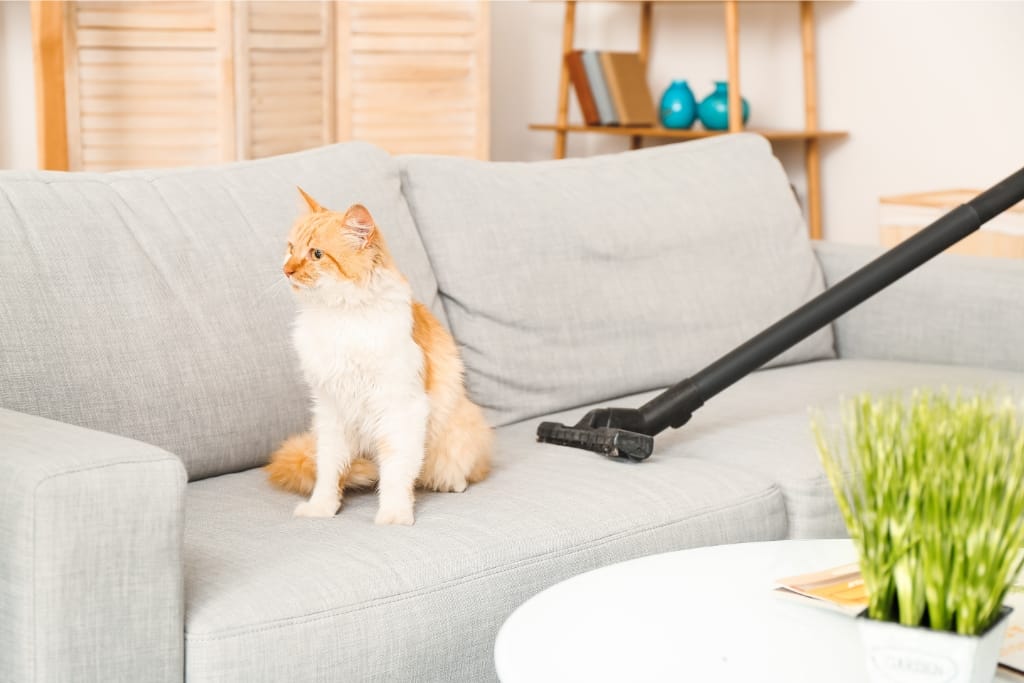Dealing with pet hair on furniture is a common challenge for pet owners, as it can accumulate quickly and cling to various surfaces.
Not only does pet hair detract from the visual appeal of your home, but it can also trigger allergies and respiratory issues for sensitive individuals.
As pets shed their fur, it often finds its way onto sofas, chairs, and other fabric-covered items, making it essential to address this issue regularly.
Left unattended, pet hair can become embedded in fibers, leading to more complex cleaning efforts and potential damage to your furniture.
Managing pet hair effectively is crucial for maintaining a clean and healthy living environment.
Maintaining a fur-free environment is essential for allergy relief, especially for those sensitive to pet dander.
Pet hair often carries allergens, including dander and saliva, which can trigger allergic reactions such as sneezing, coughing, and itchy eyes.
By minimizing pet hair in living spaces, you reduce the potential for these allergens to accumulate and circulate in the air, creating a more comfortable atmosphere for everyone in the household.
Regular cleaning and the implementation of effective strategies, such as using pet-specific covers and establishing a grooming routine, can significantly lower allergen exposure.
A fur-free home promotes both physical well-being and peace of mind for individuals and families affected by allergies.
Step 1: Prepare Your Cleaning Tools
Before diving into the cleaning process, it's essential to properly prepare your cleaning tools for effectively tackling pet hair on your furniture.
Having the right supplies on hand not only streamlines the cleaning experience but also enhances the overall efficiency of hair removal.
In this step, you'll gather an assortment of necessary tools such as lint rollers, rubber gloves, and specialized vacuum attachments designed for pet fur.
By ensuring you are well-equipped with the appropriate cleaning products and organizing your cleaning space, you will be better positioned to combat the persistent challenge of pet hair and keep your home clean and allergen-free.
Gather Necessary Supplies
When it comes to collecting effective cleaning tools for removing pet hair, lint rollers, rubber gloves, and vacuum cleaners with pet hair attachments are essential components.
Lint rollers are particularly handy for quickly lifting hair from fabric surfaces with their sticky sheets, making them ideal for a quick clean-up.
Rubber gloves, when slightly damp, create a static charge that attracts pet hair, allowing for an efficient and effective removal method.
Vacuum cleaners equipped with specialized pet hair attachments are designed to tackle the challenge of stubborn fur on various surfaces, ensuring that even the most embedded hairs are collected.
By gathering these crucial supplies, you can streamline your cleaning process and significantly improve your ability to maintain a fur-free home.
Choose The Right Cleaning Products
Choosing the right cleaning products is vital when addressing pet hair on furniture, as fabric-safe cleaners or pet hair-specific products can make a significant difference in the effectiveness of your cleaning efforts.
Fabric-safe cleaners are formulated to be gentle on various materials, ensuring that your furniture remains unharmed while effectively lifting dirt and hair.
On the other hand, pet hair-specific products are designed with unique formulations that target the sticky nature of pet hair, allowing for easier removal.
When selecting cleaning agents, it's important to read labels and opt for non-toxic, hypoallergenic options, particularly for households with allergies or sensitive individuals.
By using appropriate cleaners, you can maintain your furniture's integrity while creating a healthier living environment free from pet hair and allergens.
Organize Your Space
Clearing the area of items that might obstruct cleaning is a crucial step in ensuring a smoother and more efficient process when tackling pet hair on furniture.
Before you begin cleaning, take a moment to remove any clutter, such as cushions, throws, and decorative items, that could hinder your access to the surfaces needing attention.
A tidy workspace not only allows for easier movement but also helps you to focus on the task at hand without distractions.
Clearing away obstructions ensures that cleaning tools can reach all areas where pet hair may have accumulated, from the corners of sofas to the crevices of chairs.
By organizing your space beforehand, you set yourself up for success in maintaining a fur-free environment.
Step 2: Remove Pet Hair From Fabric Surfaces
Once your cleaning tools are prepared and your space is organized, it's time to move on to Step 2: removing pet hair from fabric surfaces.
This step is essential in achieving a thorough clean, as furniture and upholstery often become magnets for pet hair, dander, and other allergens.
By focusing on these fabric areas, you can significantly reduce allergen levels in your home and improve overall air quality.
Employing the right techniques and tools will enable you to tackle pet hair effectively, ensuring that your living environment remains comfortable and clean for everyone, especially those with allergies.
Use Lint Rollers Effectively
To effectively use lint rollers on fabric surfaces, it’s important to roll them in a consistent direction to gather pet hair.
Start by selecting a section of the fabric and roll the lint roller over it, applying even pressure to ensure maximum hair pickup.
By moving in a single direction—whether it's from top to bottom or side to side—you can capture more hair without pushing it around, which can happen if you roll back and forth.
Periodically lift the roller to check for fullness and replace the sticky sheets as needed to maintain efficiency throughout the cleaning process.
This method not only aids in the thorough removal of hair but also helps to prevent damage to the fabric, leaving your surfaces looking clean and well-maintained.
Rubber Glove Technique
The rubber glove technique is a highly effective method for removing pet hair from fabric surfaces.
To start, dampen your rubber glove slightly, as the moisture helps create a static charge that attracts pet hair.
Simply run your hand over the fabric with the glove, applying gentle pressure as you glide across the surfaces.
You'll notice that the pet hair clings to the glove, making it easy to gather and lift away from the fabric.
This technique is especially beneficial for reaching into crevices and contours of upholstery where hair often hides.
Once you've collected a substantial amount of hair, rinse the glove under water to remove the debris, and repeat the process as necessary for a thoroughly clean surface.
Vacuuming Techniques
Using a vacuum with a pet hair attachment is one of the most efficient methods for removing pet hair from various fabric surfaces.
Begin by ensuring that the vacuum is set to the appropriate mode for upholstery, as this will optimize suction and protect delicate materials.
When vacuuming, it's essential to move slowly and methodically across the surface, allowing the attachment to thoroughly lift and capture all the stray hairs without scattering them.
Pay extra attention to seams, corners, and areas where pet hair tends to accumulate, making multiple passes if necessary.
Regularly check and clean the vacuum filter and the attachment itself to maintain maximum efficiency.
By incorporating this technique into your cleaning routine, you can significantly reduce the presence of pet hair and enjoy a cleaner, more comfortable living space.
Step 3: Maintain A Fur-Free Environment
Once you've successfully cleaned pet hair from your furniture and fabric surfaces, the next step is to maintain a fur-free environment.
Step 3 focuses on developing consistent habits and routines that will help keep pet hair at bay, preventing it from accumulating and becoming a nuisance.
Regular maintenance is key, as it not only improves the overall cleanliness of your home but also contributes to a healthier living space, particularly for individuals with allergies.
By implementing effective strategies, such as frequent grooming of your pets, strategic placement of pet beds, and using air purifiers, you can create an environment that is more pleasant and free from the challenges posed by shedding fur.
Regular Cleaning Schedule
Establishing a regular cleaning schedule for your furniture is crucial in preventing pet hair build-up and maintaining a tidy home.
Aim to set aside specific days each week for a quick clean of upholstery and surfaces where pets tend to shed the most.
Incorporate techniques such as vacuuming, lint rolling, or using the rubber glove method as part of your routine.
Consider creating reminders or setting appointments in your calendar to ensure consistency, which will help you stay on track.
By making this a regular part of your household maintenance, you can significantly reduce the accumulation of pet hair and allergens, creating a more comfortable environment for both you and your furry companions.
Use Pet-Specific Furniture Covers
Using washable covers on your furniture is a smart and practical approach to protect against future pet hair accumulation.
These covers act as a barrier, preventing hair from embedding into the upholstery while also safeguarding against other potential stains and damage caused by pets.
When choosing furniture covers, opt for machine-washable options that are easy to clean, ensuring that maintenance is hassle-free.
Regular washing of the covers not only keeps your furniture looking fresh but also reduces allergens in your home environment.
Select covers that complement your decor, making it a stylish and functional solution for pet owners.
By incorporating this protective measure, you can significantly reduce the frequency and effort needed for cleaning while enjoying a pet-friendly space.
Groom Pets Regularly
Establishing a consistent grooming routine for your pets is essential in minimizing shedding indoors and maintaining a clean living environment.
Regular brushing helps to remove loose fur and dander before it has the chance to settle on your furniture and floors.
Depending on your pet’s coat type, consider grooming them weekly or even daily, using the appropriate tools to achieve the best results.
This routine not only reduces shedding but also promotes a healthy coat and skin, as it stimulates natural oils and can prevent matting.
Coupling grooming sessions with rewards or treats can make the experience enjoyable for your pet, fostering a positive association and ensuring that they look forward to their grooming time.
By implementing this proactive approach, you can effectively manage shedding and enjoy a cleaner, fur-free home.
Pro-Tip: Investing in a high-quality pet grooming kit can greatly enhance your ability to maintain a clean living environment.
High-quality tools, such as clippers, slicker brushes, de-shedding combs, and specialized grooming gloves, are designed to effectively remove loose hair and dander, making your grooming sessions more efficient.
Not only do these tools provide a deeper clean and reduce shedding, but they also contribute to your pet's overall health by promoting skin and coat vitality.
Furthermore, a good grooming kit can help you save time and effort in cleaning your home, as regular use will keep hair at bay and minimize the need for extensive clean-up.
By prioritizing your investment in quality grooming products, you are ensuring both your pet's well-being and a more comfortable, fur-free environment.
Conclusion
Effectively managing pet hair in your home requires a multi-faceted approach that includes several key methods.
First, using a vacuum with a pet hair attachment allows for efficient removal of hair from furniture and fabrics, particularly when done slowly to capture all stray hairs.
Establishing a regular cleaning routine helps to prevent hair build-up, making your cleaning efforts more manageable.
Incorporating washable furniture covers provides an added layer of protection against future hair accumulation while being easy to maintain.
Maintaining a consistent grooming routine for your pets is crucial as it reduces shedding and promotes a healthier coat.
By combining these strategies, you can create a comfortable and clean environment, reducing allergens and enhancing the overall well-being of both you and your pets.
The key methods for managing pet hair in your home revolve around proactive strategies that promote cleanliness and comfort.
Regular vacuuming with a dedicated pet hair attachment is essential for effectively removing stray hairs from various surfaces.
Setting up a cleaning routine allows for consistent maintenance, preventing hair build-up over time.
Incorporating washable furniture covers not only protects your upholstery but also simplifies the cleaning process.
Lastly, establishing a grooming routine for your pets significantly reduces shedding indoors and contributes to their overall health.
By implementing these combined approaches, you can foster a more pleasant living space, free from the challenges posed by pet hair, while ensuring the well-being of both your home and your furry friends.
Download Our Free E-book!







